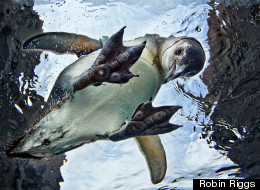The Huffington Post
|
By Lucy Blodgett
Posted: 05/16/2012

The colony of 13 Magellanic penguins got a head start on their breeding season when they moved into the new June Keyes Penguin Habitat, reports the Los Angeles Times.
Apparently, Avery and Kate are a popular penguin pair (much to the upset of Robbie the penguin). Penguins Henry and Roxy are shaking up a lot in the nest room too.
"We weren't expecting all this breeding activity until after we opened the new exhibit," said Dudley Wigdahl, curator of marine mammals and birds, to the LA Times.
Avery the Penguin is also tweeting about his new $1.5 million habitat:
Looks like we've got some VIPs coming through. I don't need to change my outfit, I'm always in black tie.
You will be able to meet Avery, Floyd, Henry, Jeremy, Kate, Ludwig, Newsom, Noodles, Patsy, Robbie, Roxy, Shim and Whatever at the habitat thanks to color coded and labeled ID tags on the penguins' wings. They can be seen up-close thanks to the new crawl-in space that allows visitors to feel as though they are inside the exhibit.
The June Keyes Penguin Habitat opens to the public on Thursday May 17. Maria the Magellanic penguin was even spotted at the Long Beach Airport, which you can see video of above.
For more information on the June Keyes Penguin Habitat check out the website and Facebook page.
source
~~~~~~~~~~~~~~~~~~~~~~~~~~~~~~~~~~~~~~~~~~~~~~~~~~~~~~~~~~~~~~~~~~~~~~~~~~~
Penguins settle in to new home at Long Beach Aquarium
Posted:
05/16/2012

These
three penguins are part of The Aquarium of the Pacific's new exhibit in
Long Beach, the June Keyes Penguin Habitat, home to the first penguins
in the Aquarium's collection. The exhibit features Magellanic penguins,
some of which were rescued from Brazil where they were stranded outside
their native habitat. Currently there are 7 penguins in the exhibit and
more in the husbandry area tending to eggs. (Brittany Murray / Staff
Photographer)
Spring is in the air for the Aquarium of the Pacific's newest residents - a colony of 13 Magellanic Penguins.
The aquarium will officially unveil its new June Keyes Penguin Habitat to the public today, but some of the birds have already begun breeding.
Assistant curator Rob Mortensen said aquarium staff was surprised when the birds, most of which arrived several months ago, began pairing up and laying eggs before their habitat home was complete.
One pair is already raising a chick and another group is attending to a clutch of eggs.
"We didn't expect them to start breeding so quickly, but apparently Mother Nature took over," Mortensen said.
Seven of the birds - six males and one female - are now on display in a 3,000-square-foot habitat built to resemble their native home along the rocky beaches of South America. The six other penguins are in a special breeding room and will be slowly introduced into the habitat once the eggs are hatched and the chicks are deemed healthy.
The habitat is designed to hold up to 24 of the buoyant black-and-white birds.
Aquarium President Jerry Schubel said the new exhibit will help educate the public about the environmental threats facing penguins across the world. More than 75 percent of the world's 17 penguin species
are threatened due to climate change, oil spills and overfishing, he said. "Perhaps never before have penguins experienced such rapid environmental changes," he said. "We can help them by choosing sustainable seafood, decreasing carbon emissions, reducing pollution and protecting areas where these penguins breed and forage."
Schubel said a common misconception is that all penguins live in chilly climates with snow and ice. Several species live in warmer temperate zones.
The
Aquarium of the Pacific debuts a new exhibit, the June Keyes Penguin
Habitat, home to the first penguins in the Aquarium's collection.
(Brittany Murray / Staff Photographer)
Marley
Brown, 3, watches swimming penguins at the Aquarium of the Pacific for
the debut of a new exhibit, the June Keyes Penguin Habitat, home to the
first penguins in the Aquarium's collection. (Brittany Murray / Staff
Photographer)
The Magellanic Penguin is native to the coasts of Chile, Argentina and the Falkland Islands. The flightless birds are named after explorer Ferdinand Magellan, who spotted them on a voyage to South American in 1519.
Four of the aquarium's penguins were rescued on a beach near Rio de Janiero in Brazil and deemed unfit for the wild because of health issues.
The penguins at the Aquarium of the Pacific won't have to worry about food. They're fed a rich diet of sardines and smelt up to three times a day.
As part of the permanent exhibit, visitors will be able to learn more about penguins through two short films, a children's program and a penguin guest speaker series.
For information call 562-590-3100 or visit www.aquariumofpacific.org.
source




















